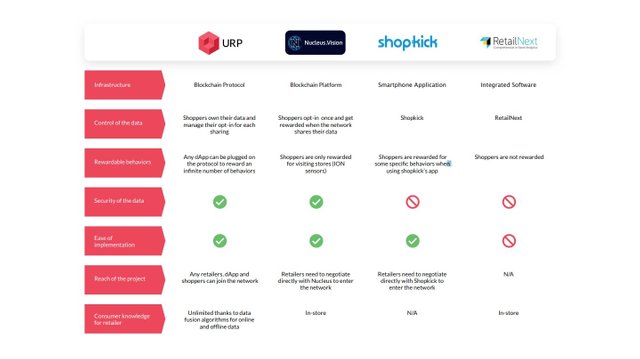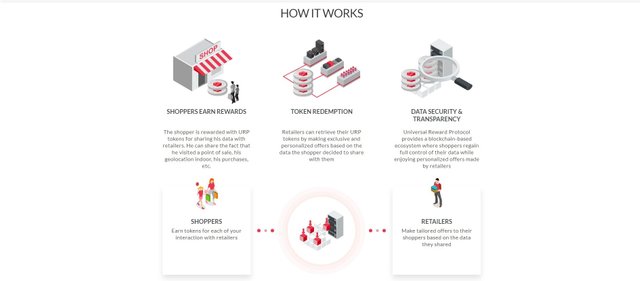Universal Reward Protocol Rewards for purchases

In the past two decades, traditional retailers and brands have had to adapt to the rise of e-commerce by diversifying distribution channels (website, click-and-collect, mobile apps). However, their main strength remains their stores, where shoppers can see, touch and try the product before buying it, which explains why 90% of retail sales still takes place in brick-and-mortar stores. Modern retailers and brands have the ability to understand, engage and reward visitors and consumers in a truly disruptive way. By bridging the gap between online and offline, retailers will have access to as many insights about their visitors’ behavior, tastes and preferences as current leading e-commerce websites such as Amazon or Alibaba. Contrary to pure players, physical retailers currently have no way of interacting directly and personally
with shoppers outside of their loyalty program or traditional mass branding campaigns. Actions to attract new visitors and/or increase conversion rates require data about potential prospects.
However, physical retailers have no information about who visits their store or what they are looking for. Therefore, it is much harder for them to personalize the communication with prospects than for e-commerce website. The asset that brick-and-mortar stores represent can be better leveraged if retailers are able to establish direct customized digital communications with shoppers and enter in a personal relationship with each of them. Shopper experience can be revolutionized and made less of a chore and more of a leisure.
So, we all do any shopping, but now we are offered to get paid for purchases, this is a very advantageous offer, which is unlikely to be rejected by anyone, let's take a closer look at what the developers of this project are offering to us.
Universal Reward Protocol, as a blockchain-based protocol, enables any retailer to join the network and easily create reward campaigns using smart contracts while granting shoppers full control and security of their data. The main advantage of Universal Reward Protocol is to be able to reward multiple behaviors online and offline. Universal Reward Protocol team is already working with major retailers worldwide that gives a concrete competitive advantage in terms of business expansion. Universal Reward Protocol is competing with traditional rewarding programs applications like Shopkick and analytics solutions made for retailers like RetailNext. As for NucleusVision, its product enables
retailers to reward shoppers who visited their store and shared data with the store manager.
Universal Reward Protocol is different by nature. It’s a rewarding protocol while Nucleus Vision is a dApp.
As a decentralized protocol, any retailer, shopper and dApp can participate in URP in a secure and trustless way.

Universal Reward Protocol (URP) is a new way for retailers and brands to interact directly and transparently with their shoppers, and automatically reward their behavior and data sharing in a personalized, streamlined way. This blockchain-based protocol lets retailers reward shoppers for any type of shopping behavior, such as simply visiting a store. By accepting to share their shopping behavior data with the network, a shopper earns reward URP tokens, while the data is used by retailers to build redemption offers that best suit each customer’s needs. Shoppers can redeem their tokens through these exclusive and personalized offers.
Through URP, retailers and brands can transparently acquire data that encompasses their shoppers’ entire online and offline behavior, enabling them to bridge the digital gap by engaging with shoppers directly across several communication channels. URP is a new performance marketing tool for retailers and brands.
Shoppers, in exchange, are rewarded for their engagement with universal tokens they can redeem through personalized offers and promotions. They have complete control over which data they share with which retailer or brand, according to the trade-off between the level of personalization they are looking for and the privacy settings they choose.

Rewarding a shopper through URP consists of a series of 8 steps:
- Retailers design campaigns in the URP web interface to incentivize their shoppers’ behavior,
specifying the conditions to fulfill and the corresponding reward. - The campaign is published on the blockchain as a smart contract.
- The campaign becomes available to shoppers.
- The shopper gives their consent to the campaign data collection and Terms & Conditions.
This consent is added to the blockchain state. - A dApp collects data on the shopper’s type of behavior relevant to the campaign.
- The dApp produces Proof-of-Behavior (PoB) data that certifies that the conditions of the
smart contract have been fulfilled. A hash of the PoB is sent to the Smart Contract. - The contract releases the reward, after PoB authentification.
- The full PoB data is encrypted and sent securely to the retailer.
Then, the shopper can choose to redeem the tokens with the same retailer, or another retailer belonging to the URP network, through a personalized offer that the retailer has created based on the previously collected PoB data.
Where traditional loyalty programs only reward purchases, URP now allows retailers and brands to
reward individual shoppers for any behavior they deem relevant to their omni-channel customer
acquisition and retainment strategy.
Under URP, retailers and brands will interact with a single component: the Campaign Manager. It is subdivided into two symmetric interfaces, the Reward Campaign Manager and the Redemption Campaign Manager.
• The Reward Campaign Manager lets the retailer define campaigns aimed at enhancing Key Performance Indicators (traffic, customer retainment, conversion rate…) by efficiently incentivizing shoppers to behave in a given way
• The Redemption Campaign Manager is a marketing targeting tool. Based on shoppers’ profiles derived from the different Proof-of-Behavior data points collected through Reward Campaigns, retailers and brands can publish personalized offers targeting In addition to the user-friendly interface, the Campaign Manager is equipped with an advanced API for programmatic use by experts. The Campaign Manager interface is therefore a tool that allows
retailers to experiment with marketing strategies, and then roll out the most efficient campaigns programmatically.
The Campaign Manager should ideally be viewed as a marketing experimentation lab; whereby retailers beta-test reward and redemption campaigns on smaller sub-groups to identify which strategies are efficient before rolling these out to a larger audience in a programmatic fashion. In addition to the user-friendly interface, the Campaign Manager is equipped with an advanced API for programmatic use by experts. As a conclusion, URP enables retailers to tailor targeted offers to their shoppers and incentivize their behavior and data sharing by providing straightforward campaign creation and monitoring tools. The two following sub-section details in depth the roles of the Reward Campaign Manager and the Redemption Campaign Manager.
The Reward Campaign Manager component has two main design goals :
• to create new reward campaigns by specifying the conditions under which shoppers will be rewarded
• to analyze existing campaigns to check their performance The Reward Campaign Manager lets the retailer create a new reward campaign by filling fields in a template, such as follows: Mandatory fields:
• Total amount of URP tokens allocated
• Amount of URP per reward trigger (including additional fees to support the reward contract execution ecosystem)
• Type of behavior targeted (visit / purchase / engagement …) Optional fields:
• Socio-demographic and/or geographic filters
• Start date and Termination date
• Maximum number of triggers per customer
• Rolling or Adoption Threshold (“Groupon-style” offer that is only valid if a sufficient number of shoppers agree to it)
• Advanced triggering rules (e.g. “Reward shoppers who return to a store after a prolonged absence”, “The Amount of tokens distributed is function of the amount spent”, etc.)
I think the project is quite promising and in demand, I advise you to look at it and study in more detail.
Website: https://rewardprotocol.com
Whitepaper: https://rewardprotocol.com/wp-content/uploads/URP_Whitepaper-1.pdf
Telegram: https://t.me/UniversalRewardProtocolOfficial
Twitter : https://twitter.com/RewardProtocol
My Profile Bitcointalk : https://bitcointalk.org/index.php?action=profile;u=1220142
ETH Address : 0x238BBaD7ccfa5Ff685783CF1d2Bc08C41f63556F